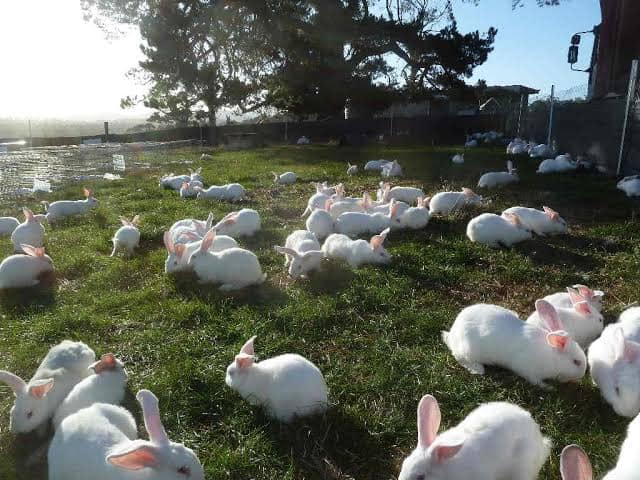RABBIT FARMING IN KENYA
Rabbit farming is the practice of raising domestic rabbits for reasons like meat production, fur, wool, laboratory research and also as pets. It can be a very profitable agribusiness for anyone who is well informed about animal husbandry.
Rabbits also require low capital to start unlike other livestock farming. Rabbit farming can be a lucrative and sustainable agricultural venture, especially for small-scale farmers or those looking to diversify their livestock operations. Before venturing into the rabbit-breeding business, it is imperative to be well- grounded in the knowledge of the animals, how to raise them and which customers to approach for marketing.
Hence if you are interested n rabbit farming you need to know the following.
1. Constructing a house for your rabbits
Rabbits are very sensitive to space and they should be granted enough space so that they can move freely and comfortably. A well-designed hutch provides essential shelter, security, and comfort for the rabbits while facilitating efficient management of the farming operation. Typically, the construction process begins with thoughtful planning, considering factors such as the number of rabbits to be housed, available space, and prevailing climatic conditions. Materials like untreated lumber, wire mesh, and weather-resistant roofing are commonly used to build the hutch. The frame is carefully assembled, ensuring sturdiness and structural integrity. Wire mesh is affixed to the sides of the frame to allow ventilation and prevent predators from gaining access, while a solid floor provides
a comfortable surface for the rabbits to rest on.
2. Breeding and production of rabbits
Before starting rabbit farming in Kenya you should have good knowledge about the breeds. Rabbits typically reach sexual maturity and begin breeding between the ages of 4 to 6 months, depending on factors such as breed, genetics, and environmental conditions. However, its essential to consider individual rabbits; readiness for breeding based on their health, size, and overall development. Female rabbits, known as does, can start breeding as early as 4 months old, although its generally recommended to wait until they are closer to 5 to 6 months old for optimal reproductive health. Breeding does too early can increase the risk of complications during pregnancy and delivery. For reproduction to take happen, the buck and doe must be kept together to induce mating, after which they should be
kept in separate cages. Bucks should be used for reproduction at least once in four days. The mating process could be scheduled for every three weeks or every six weeks depending on your level of patience.
3. How to feed rabbits and what to feed them
Feeding rabbits is essential for their health and well-being, and a balanced diet is crucial to ensure they receive the necessary nutrients. The foundation of a rabbits diet should be high-quality hay, such as Timothy, orchard grass, or meadow hay, which provides essential fiber for proper digestion and dental health. Hay should be available to rabbits at all times, allowing them to graze freely throughout the day.
In addition to hay, rabbits should be offered a variety of fresh vegetables, including leafy greens like romaine lettuce, kale, spinach, and parsley. These vegetables provide essential vitamins and minerals to support overall health. Its important to introduce new vegetables gradually to prevent digestive upset and monitor rabbits for any adverse reactions. Commercial rabbit pellets formulated specifically for rabbits can be fed in limited quantities to provide additional vitamins and minerals. Pellets should be offered in measured amounts, with adult rabbits typically receiving about 1/8 to 1/4 cup per 5 pounds of body weight per day. Its crucial to avoid overfeeding pellets, as this can lead to obesity and other health issues. Fresh water should be available to rabbits at all times, provided in a clean water bottle or heavy ceramic dish to prevent contamination. Monitoring water consumption is essential, especially during hot weather, to ensure rabbits stay hydrated.
4. Market for rabbits
The market for rabbits presents a diverse array of opportunities, ranging from meat production to fur, wool, pets, and even laboratory research. Rabbit meat, known for its lean and nutritious qualities, holds a significant place in various cuisines worldwide, offering a healthy alternative protein source. Additionally, rabbit fur and wool are valued in the fashion industry for their softness, warmth, and sustainability. Beyond these commercial uses, rabbits are also cherished as pets for their gentle demeanor, low maintenance, and suitability for indoor or outdoor living. Furthermore, rabbits play a crucial role in laboratory research, contributing to advancements in medical science and pharmaceuticals. With such versatility and demand across multiple sectors, the market for rabbits continues to present diverse opportunities for farmers and businesses alike, fostering innovation, sustainability,
and economic growth.
CHALLENGES FACING RABIT FARMING
Rabbit farming, often touted for its sustainability and nutritional benefits, faces a myriad of challenges that demand attention and innovative solutions. While rabbits offer a promising source of lean protein and are renowned for their efficient reproduction, the industry grapples with obstacles ranging from limited market demand to complex health management issues. Here are some key challenges:
1. Lack of awareness and market demand:
Rabbit is not commonly popularized as other types of meat like beef, chicken or pork in many other parts of the world. This lack of consumer awareness and demand can pose significant challenges for rabbit farmers. Without a strong market for their products, rabbit farmers may struggle to sell their meat, leading to financial instability and potentially forcing some farmers out of the industry.
2. High initial cost to start:
Starting a rabbit farming operation requires significant upfront investment in infrastructure, equipment, and breeding stock. This includes building suitable housing facilities, purchasing feeding and watering systems,
acquiring breeding rabbits, and investing in veterinary care and other operational expenses.
3. Predation and disease management:
Rabbits are vulnerable to predation by various predators such as foxes, raccoons, birds of prey, and even domestic pets like cats and dogs. Predation can lead to significant losses for rabbit farmers, affecting both their livestock and financial viability. Additionally, rabbits are susceptible to various diseases, including respiratory infections, gastrointestinal disorders, and parasitic infestations. Preventing and managing predation and disease outbreaks requires implementing effective biosecurity measures, practicing proper hygiene and sanitation protocols, and providing appropriate veterinary care.
4. Feed costs and availability:
The cost and availability of rabbit feed can fluctuate depending on factors such as seasonal variations, market demand for feed ingredients, and competition from other livestock industries. Rabbit feed typically
consists of a balanced mixture of hay, pellets, grains, and fresh greens to meet their nutritional requirements. Ensuring a consistent and affordable supply of high- quality feed is essential for maintaining rabbit health and maximizing production efficiency. However, fluctuations in feed prices or shortages of key ingredients can increase production costs for rabbit farmers, impacting their profitability and sustainability.
5. Reproductive challenges:
While rabbits are known for their prolific breeding capabilities, maintaining optimal reproductive health and managing breeding programs can present challenges for rabbit farmers. Factors such as inbreeding,
reproductive disorders, and low fertility rates can impact the productivity and profitability of rabbit farming operations. Breeding rabbits require careful selection and management to ensure genetic diversity, minimize the risk of hereditary diseases, and optimize reproductive performance.
6. Marketing and distributing challenges:
Establishing reliable marketing channels and distribution networks for rabbit meat and related products can be challenging, especially for small-scale or niche producers. Building relationships with wholesalers, retailers, and consumers, as well as promoting the nutritional and culinary benefits of rabbit meat, is essential for expanding market reach and driving demand. However, competition from other meat sources, limited consumer awareness, and logistical barriers may hinder the marketing and distribution efforts of rabbit farmers. Developing innovative marketing strategies, leveraging digital platforms, and collaborating with local communities and culinary professionals can help overcome these challenges and create opportunities for market growth and
diversification.





